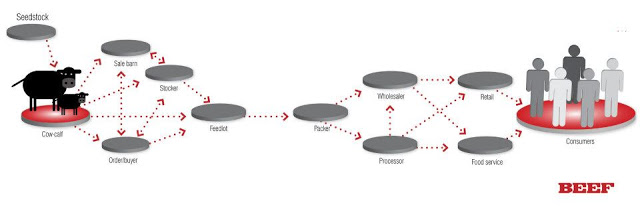This time of year I always feel like we are doing lots of buying and selling of cattle. I could explain all that goes in to that, and the prices of the markets, etc. But, I think something a little more beneficial is much more fun!
I came across this diagram from BEEF magazine and I thought it was perfect for this post. It is so important to understand where your food comes from and this does a perfect job of describing that.
Cattle production starts with a cow/calf producer as you can see in the diagram. Calves are anywhere from 60 to 100 pounds when born. They are typically weaned at around 6 to 10 months of age.
After calves are weaned they can go a number of places. They can be put back into the herd for breeding purposes, sold to a feed lot, or in some cases sold to a “backgrounder” that will graze the calf on grass a little longer.
Calves typically spend anywhere from 4 to 6 months in a feedlot where they are grain-finished. We refer to the time calves spend in a feedlot as the “finishing phase”.
Some cattle are considered grass fed and will be on pasture for their “finishing phase”. I think it’s important to point out that no matter if the calf is finished on grass or in a feed lot, cattle spend most of their lives on pasture.
Once cattle reach the ideal weight- anywhere from 1,200 to 1,400 pounds they are sent to a processing facility. After being processed the calf will then enter the food supply.
At all different stages of a calf’s life their are many people involved in their safety, health, and happiness.
As producers we work with veterinarians and nutritionist to give the best possible care. At the processing facility USDA inspectors are in charge of ensuring the animal’s welfare and health.


Leave a Reply